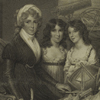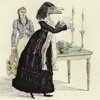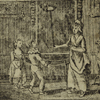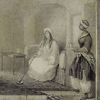Rational dames and Intrepid Travelers
 A Compendious
A Compendious
System
of Astronomy ...
NYPL, Pforzheimer
Collection
 A Downwright Gabbler,
A Downwright Gabbler,
or a Goose That
Deserves to Be Hissed
NYPL, Print Collection
 The History of Mary
The History of Mary
Wood,
the House-Maid…
NYPL, Pforzheimer
Collection
![[Ada Byron]](images/sqthumb/ps_cps_cd3_047.jpg) [Ada Byron]
[Ada Byron]
NYPL,
Pforzheimer
Collection
The previous section focused
on women who worked in the realms of the imagination. This
one concentrates on those who explored the material world, whether
through science or travel. Education for women in the Romantic era was
underdeveloped.
Most people agreed that poor girls should be literate, but many educators
limited their teaching to reading without writing. Genteel girls were
taught in boarding schools that mostly emphasized the “accomplishments”—fluffy
subjects like drawing, dancing, and manners. One advance was made, however,
that would later be lost: science education. Science was not much taught
in the universities, and so did not have the masculine cachet of the classics.
Since work in elementary zoology, botany, mineralogy, astronomy, and other
disciplines could easily be carried on from a country house, there was no
reason for girls not to engage in these subjects. Many of their science
textbooks were anything but fluffy, and many were written by women. In the
Victorian era, as the sciences became professionalized, women were shut
out, but some extraordinary early women in science— among them, Caroline
Herschel, Ada Byron, and Mary Somerville—are remembered.
 Memoirs of the
Lady
Memoirs of the
Lady
Hester
Stanhope
NYPL,
Pforzheimer
Collection
Women travelers, too, sought to learn about the material world, and needed
a great deal of courage to set off. Some, like Frances Trollope, were economic
emigrants; others, like Lady Hester Stanhope, sought freedom from social
convention. Travel later became a genteel pursuit for the whole family,
and unlike early scientists, women travelers were followed by generations
of successors.




![[Ada Byron]](images/sqthumb/ps_cps_cd3_047.jpg)
